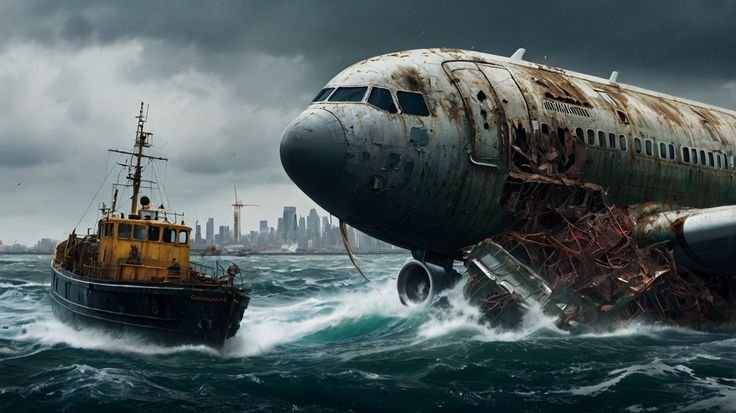Introduction: The Haunting Phenomenon of Ghost Ships
Across the vast expanse of the world’s oceans, tales of ghost ships have long captivated the imagination of sailors and storytellers. These are not fictional pirate vessels or haunted legends alone — in recent years, several real-life ships have been discovered drifting aimlessly without a single soul aboard. The mystery surrounding these vessels has left maritime experts, investigators, and ocean lovers around the world baffled.
The Most Famous Modern Ghost Ships
While tales of ghost ships stretch back centuries, some of the most chilling examples have emerged in modern times. One of the most notorious is the MV Lyubov Orlova, a Russian cruise ship that broke loose while being towed in 2013. It was set adrift in the North Atlantic and reportedly carried only rats, left to roam its rusting decks. The ship was never officially recovered, and sightings remain unconfirmed, giving it an eerie place in maritime lore.
Another modern enigma is the High Aim 6, a Taiwanese fishing boat found drifting near Australia in 2003. The vessel was in perfect working order, with food still in the galley and fuel in the tank — but its entire crew had vanished without a trace.
Possible Explanations: Pirates, Weather, or Mutiny?
Theories abound regarding how these ghost ships come to be. In some cases, piracy is suspected — especially in regions like the Strait of Malacca or off the coast of Somalia. Crews may have been kidnapped, killed, or forced to abandon ship.
Others believe severe weather can cause chaos at sea, especially on small vessels. Rogue waves, sudden storms, or mechanical failures could cause panic and abandonment. In some strange cases, theories of mutiny or mental breakdowns among crew members have also surfaced.
Maritime Laws and Salvage Rights
Under international maritime law, a ship found adrift with no crew falls under the rules of salvage. This means that whoever finds the vessel can potentially claim ownership or financial reward, provided they can tow it to a safe harbor. However, recovering a ghost ship can be expensive and dangerous — particularly when the reason for abandonment is unknown.
In some cases, nations have refused entry to ghost ships due to fears of contamination, stowaways, or unexplained hazards. This makes the resolution of these mysteries even more complex.
Technologies Tracking the Uncrewed Drifters
With advancements in satellite technology and oceanic monitoring systems, ghost ships are easier to track today than in the past. Many modern vessels carry AIS (Automatic Identification Systems), which send location and identification data to coastal stations and other ships.
However, if the ship’s systems are shut off — either deliberately or due to power loss — it becomes a silent drifter, nearly impossible to locate. Some experts propose expanding global maritime tracking networks and using drones or AI to assist in ghost ship detection.
Cultural and Historical Legends
The mystery of ghost ships has fascinated humans for generations. Perhaps the most legendary of them all is the Flying Dutchman — a phantom vessel doomed to sail the seas for eternity. Mariners once claimed to see her glowing in the fog, a bad omen of impending doom.
In Japanese culture, the tale of the Utsuro-bune tells of a hollow boat washing ashore in 1803 with a strange woman aboard, speaking an unknown language. Whether based in truth or fiction, these legends tap into our collective fear and wonder about the ocean’s untamed mysteries.
Environmental and Safety Concerns
Beyond their haunting aura, ghost ships pose real-world dangers. These vessels can become floating hazards to other marine traffic. If they run aground or break apart, they may cause oil spills or other environmental damage.
Some ghost ships have been found leaking fuel or carrying toxic substances. Others attract looters or become unsafe for would-be explorers. Governments and coast guards are increasingly working to manage and remove these vessels as part of ocean safety strategies.
Documented Cases That Remain Unsolved
There are numerous ghost ship incidents that still defy explanation. The Kaz II, found off the coast of Australia in 2007, is one such mystery. The yacht was found in pristine condition, with a laptop still running and dinner set on the table — yet the three men aboard were never seen again.
The Carroll A. Deering, a schooner found grounded in 1921 with meals prepared and all crew missing, remains another historic enigma. The disappearance of its crew has spawned theories ranging from hurricanes to piracy, mutiny, and even alien abduction.
Modern Interest and Media Fascination
Ghost ships continue to appear in documentaries, podcasts, and fiction. Shows like Drain the Oceans and Mystery at Sea often explore these real-life nautical puzzles. Social media also plays a role — images and stories of abandoned vessels go viral, attracting millions of curious viewers.
Authors and filmmakers often draw from ghost ship cases to craft thrillers and horror stories. From novels to Hollywood films, the haunting image of a crewless ship drifting on endless waters is a compelling narrative device.
What the Future Holds: Solving Ocean Mysteries
With climate change increasing the severity of storms and altering sea routes, the potential for ghost ship incidents may increase. Additionally, as more private vessels and autonomous boats explore the seas, maritime mystery could evolve into new forms.
To prevent tragedies and mysteries, experts call for more robust emergency protocols, real-time tracking, and international collaboration. Still, even with advanced tech, the ocean holds secrets that may never be fully revealed.
Conclusion: The Eternal Drift of the Unknown
Ghost ships are more than eerie anomalies — they are reminders of how little we truly control the sea. They speak to the power of nature, the fragility of human systems, and the endless mystery that the oceans still hold. While technology may help solve some cases, others will forever drift in legend, haunting our imaginations like the waves that carry them.


